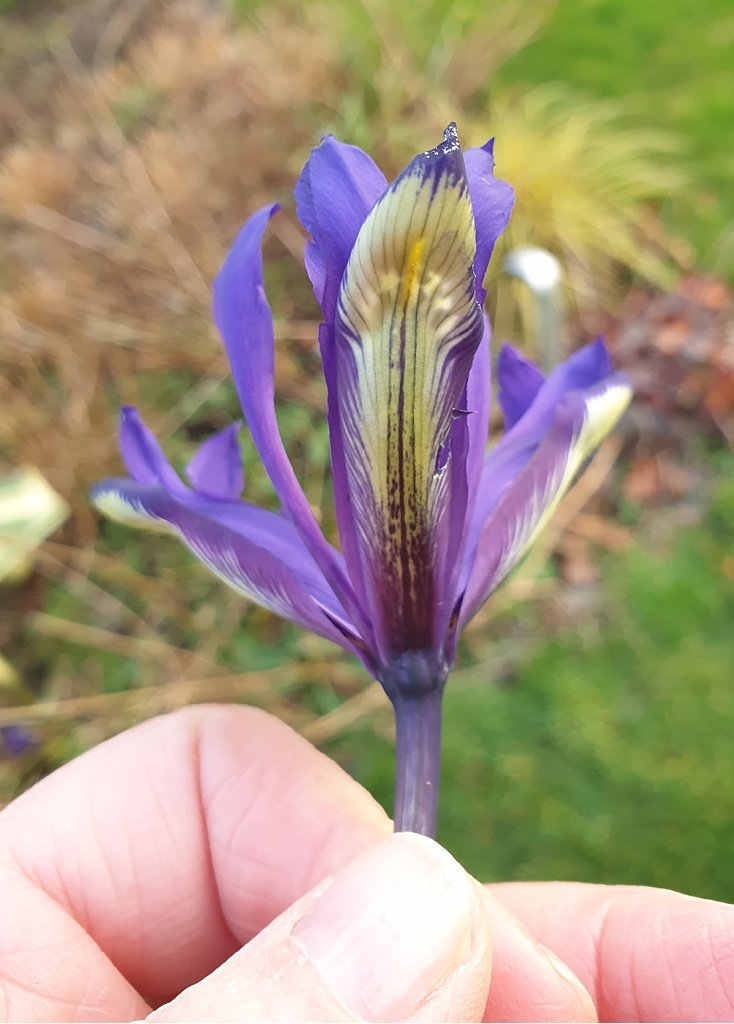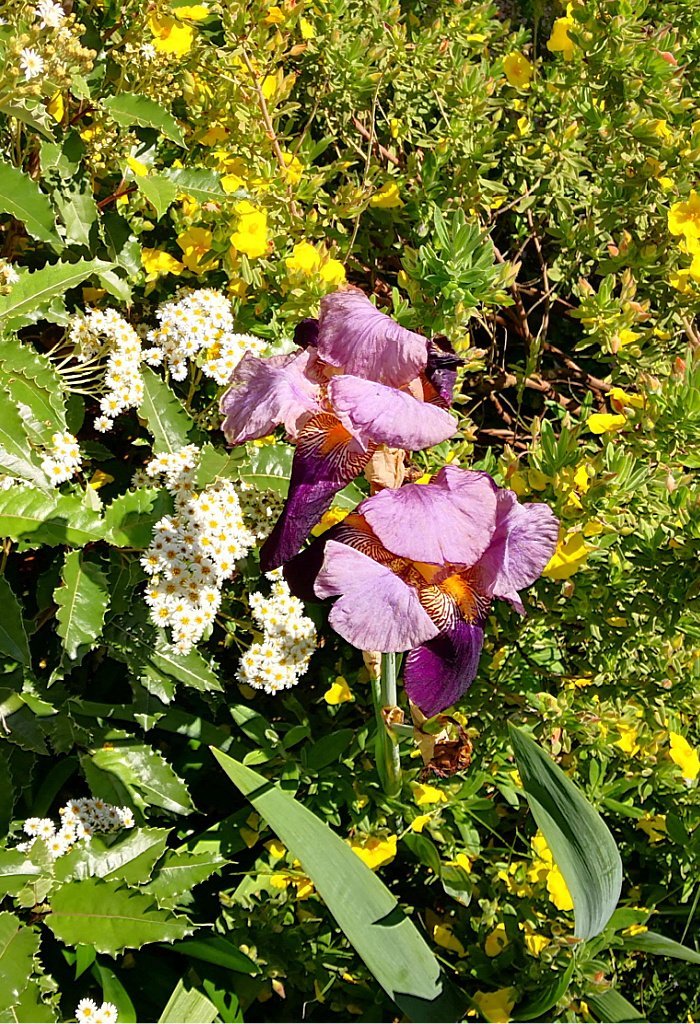Irises for an early show
Come the spring, those slugs which have survived the winter by skulking under stones in the rock-garden,or under outdoor pots, stretch themselves and think about irises in spring. Except in slug world they are known as ‘breakfast’.
As it’s spring, the Hostas haven’t appeared, while the Ligularia are no more than ground-level buds. Two more sluggy, snaily, favourites. But not much eating there for our slimy chums, this early in the season.
To the discriminating, gourmet gastropod, nothing could be more tasty than the scrunchy, munchy stems of the early dwarf irises, especially I. reticulata, histriodes and danfordiae (a particular favourite of the slugs and mine).

(Above) To see the fine detail on these wee spring irises, you have to bend down a long way. The slugs know this and so, to help, they nibble through the stems and you feel obliged to pick up the felled bloom. Grrr.
Iris reticulata – probably best known
Of this trio of fairly well known little irises in spring, probably reticulata is the most common. Its vivid purple shoots up only six inches out of the bare spring ground along with thin spikes of green leaves.
Danfordiae is lemon-yellow and scented with it (if you’re prepared to get on your knees). For all I know, this may mean an extra taste zesty taste sensation for the average slug.
Histriodes is a paler mauve than reticulata and probably the one you see in supermarkets the least, in those wee hanging-up bags.
The name means ‘brightly coloured like an actor’ and comes from the same root as the word histrionics. However, my histriodes are definitely not play-acting as they lie there, cut down by the slimy vandals.
In fact, sometimes I wonder why I keep trying to grow them. Oh wait, It’s because when they do survive they make such a good show early in the year that we gardeners like to persist – oh, just for one more year.
Irises in spring – and ‘bulblets’
These spring miniature irises have the further annoying habit of dividing themselves up into small bulbs after flowering. These little bulblets also make tasty little snacks for our sleekit, slippery pals.
Those irises that survive take a year or two to flower again, so that the one unexpectedly pops up long after you think you’ve lost the lot.
I remember long ago on an April morning climbing away above Delphi in Greece, by a steep cliff path behind the ancient site. (There are only so many Doric columns you can take…) The track came out on to a high plateau with drifts of wee yellow irises – such an unexpected delight – and I met a tortoise and a blue rock thrush there as well, and…oh sorry, let’s get back to the irises.
Mind you, the iris tribe, originally growing wild in all kinds of habitats in the northern half of the world, has plenty more members and is a particularly complicated family.

Anatomy of an Iris
Iris leaves are arranged in two groups of three. The outer three are called falls, the inner three are known as standards.
I thought you should know this, should you ever fall into conversation with an iris fancier. (Or my mum-in-law.)
As well as irises from bulbs there are those that grow from rhizomes. Actually, I think we’ll leave the complications for another time – except to repeat what old-time gardeners advised – that the rhizomes should be open to the sun.
(Och, sometimes I think these big irises are just a scutter.)
Irises – all flounces and falderals
This is an awful confession: but I don’t think I like those early summer irises very much. They seem a but, uhmm, showy or histrionic – as if they were just posing, all flounces and falls, trying to hog the border.
And the show seems over in no time. Oh, except you have to give them space – bake those blessed rhizomes as mentioned above.
But they are a favourite of the garden designer and the, uhmm, ‘plants-woman’.
So, back with the wee spring ones, as for protecting them from the sluggy tribe, you might be tempted to make free with those wee blue metaldehyde pellets – that well-known molluscicide. (Yes, that really is a word.)
Please don’t. Those horrible wee blue things are toxic to cats and dogs, hedgehogs and toads – and probably won’t feel your friendly local blackbird and song-thrush feel on top of the world either.

Metaldehyde – get rid of it
Just do the environment a favour and dispose of them safely – ask your local authority’s waste people’s advice if necessary.
In any case, this noxious substance is banned from use in our own Untied Kingdom after March 2022. (Check its use in you own country, obviously.) At least, that was a UK government announcement.
Still, who knows? Chiltern Farm Chemicals, the company that manufacture the stuff, had previously managed to overturn an earlier ban, their MD gloating that ‘“The sell-out and use-up periods previously put in place no longer apply – it is business as usual…”
This is another way of stating ‘Stuff the environment – this is about profit…’
There are less harmful alternatives – ferric sulphate for instance. But, personally, I’d make friends with as many frogs, toads, blackbirds and hedgehogs as possible.
Remember that alpines for spring are another garden delight.
